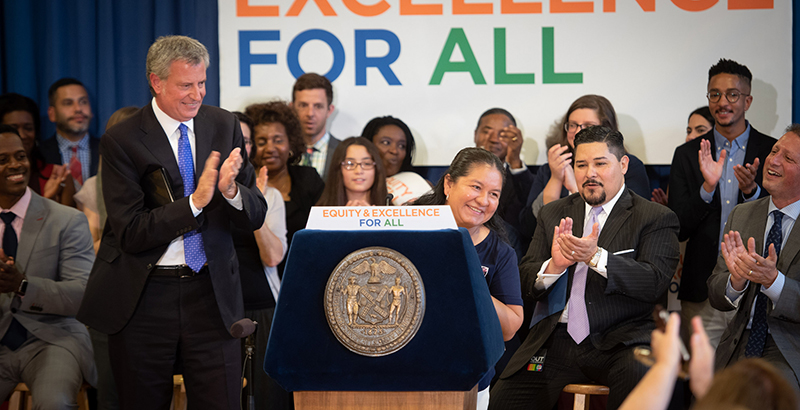De Blasio Approves Landmark, Parent-Led Desegregation Plan for Brooklyn Middle Schools

In a potentially momentous move that undoes decades of school practice, New York City Mayor Bill de Blasio endorsed a plan Thursday to desegregate schools in some of Brooklyn’s most affluent neighborhoods.
Applicants for middle school in District 15 — where the mayor once served on the school board — will no longer be selected based on their grades, test scores, or auditions. Those screens, supporters of the desegregation plan argue, created stark racial and income imbalances. White students have for years clustered disproportionately in a handful of top-performing district schools that heavily feed into the city’s elite specialized high schools.
Admissions, starting this fall for next year, will be determined using a lottery system that ensures that slightly more than half of each school’s seats are reserved for students who are low-income, homeless, or learning English — a proportion that reflects the district.
“I’m here to formally approve the District 15 diversity plan,” announced de Blasio to a cheering audience at M.S. 51, the high-achieving school his children attended. Approval of at least most of the plan had been widely expected.
He was joined by his schools chief, Richard Carranza, who has ardently advocated for efforts to desegregate the city’s schools. Encircled by three dozen festive principals and supporters waving signs that said “Equity and Excellence for All,” de Blasio added, “You can feel in the air in this city momentum for diversity is growing, momentum for change is growing.”
District 15 encompasses well-to-do areas like Cobble Hill and Park Slope, as well as public housing in Red Hook and parts of Sunset Park, home to Asian immigrant communities.
That mix hasn’t translated into diverse student bodies in nearby schools.
A 2016 Chalkbeat analysis found that at the district’s top three middle schools, 50 percent of students were white, while at the other nine middle schools, only 10 percent were white. In all, District 15 students are 30 percent white, 36 percent Hispanic, 14 percent black, and 16 percent Asian, according to the Department of Education.
Parent leaders in the district initially developed the plan independently of the administration, which later joined the effort.
Their reward Thursday included a commitment of $500,000 from the city to support the new admissions procedures, as well as expanding ethnic studies and restorative discipline practices.
“It’s not just about admissions,” said Carranza. “It’s about curriculum. It’s about inclusive practices. It’s about social-emotional learning.”
De Blasio said the city would support similar plans in other districts, and he announced $2 million in grants that will go to districts that take up the invitation.
The District 15 plan follows the passage of a new admissions initiative in Manhattan’s District 3 that reserves 25 percent of middle school seats for low-scoring students. The plan follows a heated rezoning battle in the district and an earlier showdown in Brooklyn Heights that reflected long-standing racial and economic divisions in the city’s public schools.
Earlier this spring, de Blasio and Carranza released a proposal to replace the specialized school admissions test in order to boost enrollment of black and Hispanic students, who comprise 10 percent of the enrollment in the sought-after schools even though they are nearly 70 percent of the system citywide.
The plan has been embraced by desegregation and civil rights advocates but fiercely opposed by groups representing Asian-American students, who tend to excel on the test and make up 60 percent of the math- and science-focused schools.
Get stories like these delivered straight to your inbox. Sign up for The 74 Newsletter

;)
